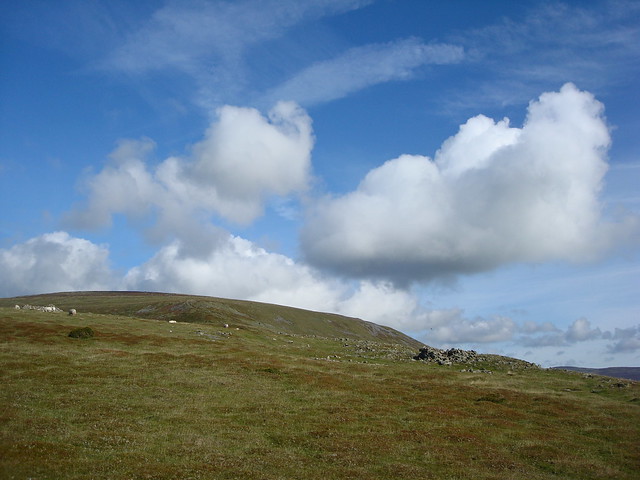For the first time in five days it had stopped raining. Above me, the Welsh sky was a vivid cerulean blue, set off against the evergreen slopes of the Black Mountains. The air meanwhile, smelled of spruce and sheep droppings. Not necessarily the most welcome aroma first thing in the morning, but I didn’t care. I was content to simply stretch my legs for an hour or two. Balancing on the steps of a stile that led over an old farm wall, I paused to consider the smartest thing I’d done all week: slow down.
Thus far, my impressions of the little country squeezed between England and the Irish Sea had been formed from the driver’s seat of a rented car. Morning after dreary morning I’d picked at plates of fried eggs, fried sausage, fried mushrooms, and yes, fried tomatoes, before setting off under cloudy skies on a peculiar mission. As a beer writer and aspiring brewer, I had designed a trip around a handful of cider makers in southern Wales. The problem was, my busy itinerary made no allowances for leisurely mornings or accidental discoveries. And so, for five straight days I wolfed down hearty if unhealthy meals in order to keep my appointments with apple growers.
Today however, was different. Encouraged by the muted yellow glow creeping under the curtain of my room at the Bear Inn in Crickhowell, I decided to forgo the complimentary breakfast and postpone my afternoon plans. Instead of loading up on calories, I would splurge on a change of scenery. This was my chance to see Wales before she put on her Wellies. Remembering a map of the area I’d picked up at Reception the night before, I took a look at the town plan and discovered that the Beacons Way, a one-hundred-mile hiking trail across Brecon Beacons National Park ran quite close to the hamlet. Estimating the distance from my hotel to the trailhead, I figured I could make it to the nearest mountain and back before checkout time. Crug Hywel. My tongue stumbled on the words as I sounded out its Celtic syllables. But a symbol on the map intrigued me; during the Iron Age a hill fort stood atop the 1,480-foot summit of Table Mountain. I wondered whether any part of the prehistoric fortification survived.
Not sure what I’d find but wanting to take advantage of a bright autumn morning, I set out with a bottle of water and a package of shortbread to quiet my stomach. While I climbed the small massif, the sun rose in the sky, its rays warming my skin under the black T-shirt I wore. Underfoot the thick carpet of moss and grass was wet from consecutive days of foul weather. Soon my socks were damp, too. Pushing through the garden of ferns growing on the mountain’s slopes, I decided to eat a few of the plump blackberries I had picked earlier on. Popping a piece of fruit into my mouth, I savored its sweet taste as I walked. Part of me dreaded returning to the car.
At the halfway point I stopped to listen. Unseen birds called to each other from either side of the footpath and somewhere a dog barked repeatedly, alerting anyone within earshot of a stranger’s presence. Soon I would rest, but I still had a short distance to go. Steadying myself with the aid of the stile’s wooden post, worn smooth by years of passers-by, I swung my leg over the stone barrier in front of me, and focused my gaze on the flat landform ahead: Table Mountain.
Half an hour later I reached a fork in the trail and followed the left branch as it curved behind the landmass, leading through another minefield of manure. In spite of the passage of time, Crug Hywel remained well defended. Carefully selecting my last few steps, I wished I had brought another pair of shoes. I couldn’t let footwear derail me this close to my destination though. I scrambled over the eroded rampart, eager to soak up the view and investigate any prehistoric ruins.
The top of the hill was already occupied. Everywhere I looked sheep milled about in small groups, rested in pairs, or leisurely grazed on the grassy summit. They scattered when I got too close, but otherwise seemed uninterested in bipedal company. I thought of the flock of tourists back at the Bear Inn, staring out at a tiny courtyard from a drab dining room. Sure, I was missing breakfast, but the chance to see the countryside more than made up for any lost calories. I drained the rest of my water bottle and bit into the first of my buttery shortbread cookies. Even though I wasn’t particularly hungry yet, the crumbly snack tasted good—as good as some of the more extravagant meals I’ve enjoyed in my travels. Breakfast on the road might be just as important as it is at home, but not necessarily because of the food we order. What counts, I decided then, is where we choose to eat it.
Suddenly I heard noisy breathing behind me. Something moist brushed against the hand that held my now empty water bottle. Turning around, I found myself nose to nose with a hungry ruminant. She took a step backward, hesitantly. Happy to spend some time with a local, I broke off a piece of shortbread and slowly offered it to my new friend. Breakfast at Table Mountain would be for two.
Subscribe to:
Post Comments (Atom)





No comments:
Post a Comment